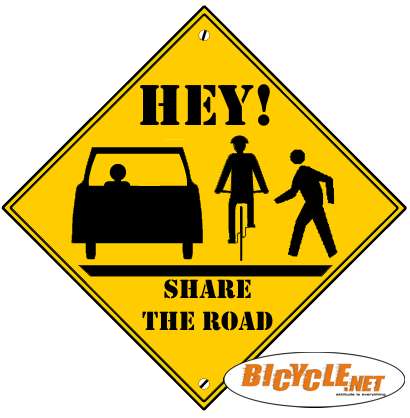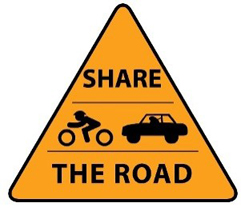Gassholes of Washington County
If you've been out on a country road in Oregon anytime in the last few years, you've probably seen this sign:

The sign's design and wording single out bicyclists as the travelers most in need of understanding and patience on the part of motorists. The main reason for making this distinction is that cyclists have fewer accident-avoidance options than walkers or runners, who can usually step off the road surface without risking injury (though, as I've pointed out in a recent post, this is not always the case, especially in areas with raised road surfaces and limited shoulders). The sign does suffer from a lack of specificity, however. An especially aggressive driver might interpret it to mean it's up to the cyclist to do the "sharing" by getting out of his or her way. In fact, Oregon law specifies exactly what a driver must do when overtaking a bicycle:





The sign's design and wording single out bicyclists as the travelers most in need of understanding and patience on the part of motorists. The main reason for making this distinction is that cyclists have fewer accident-avoidance options than walkers or runners, who can usually step off the road surface without risking injury (though, as I've pointed out in a recent post, this is not always the case, especially in areas with raised road surfaces and limited shoulders). The sign does suffer from a lack of specificity, however. An especially aggressive driver might interpret it to mean it's up to the cyclist to do the "sharing" by getting out of his or her way. In fact, Oregon law specifies exactly what a driver must do when overtaking a bicycle:
ORS 811.065 Unsafe Passing of a Person Operating A Bicycle
(1) A driver of a motor vehicle commits the offense of unsafe passing of a person operating a bicycle if the driver violates any of the following requirements:
- (a) The driver of a motor vehicle may only pass a person operating a bicycle by driving to the left of the bicycle at a safe distance and returning to the lane of travel once the motor vehicle is safely clear of the overtaken bicycle. For the purposes of this paragraph, a 'safe distance' means a distance that is sufficient to prevent contact with the person operating the bicycle if the person were to fall into the driver's lane of traffic. This paragraph does not apply to a driver operating a motor vehicle:
- (A) In a lane that is separate from and adjacent to a designated bicycle lane;
- (B) At a speed not greater than 35 miles per hour; or
- (C) When the driver is passing a person operating a bicycle on the person's right side and the person operating the bicycle is turning left.
- (b) The driver of a motor vehicle may drive to the left of the center of a roadway to pass a person operating a bicycle proceeding in the same direction only if the roadway to the left of the center is unobstructed for a sufficient distance to permit the driver to pass the person operating the bicycle safely and avoid interference with oncoming traffic. This paragraph does not authorize driving on the left side of the center of a roadway when prohibited under ORS 811.295, 811.300 or 811.310 to 811.325.
- (c) The driver of a motor vehicle that passes a person operating a bicycle shall return to an authorized lane of traffic as soon as practicable.
(2) Passing a person operating a bicycle in a no passing zone in violation of ORS 811.420 constitutes prima facie evidence of commission of the offense described in this section, unsafe Enrolled Senate Bill 108 (SB 108-BCCA) Page 1 passing of a person operating a bicycle, if the passing results in injury to or the death of the person operating the bicycle.
(3) The offense described in this section, unsafe passing of a person operating a bicycle, is a Class B traffic violation. (Maximum fine of $360.)
With that wording in mind, a safe passing distance probably looks like this:

Most of the time when I'm bicycling on rural roads, that's what it looks like when I'm passed. Drivers wait until it's safe for them to pass, then steer a wide enough berth that I have no fear of falling into the path of their wheels. Other state laws spell this out as the "three foot rule," but the wording of the Oregon law is, I think, better in that a bicycle with a rider is typically much taller than three feet.
Why am I revisiting a topic I so recently wrote about? Because I just spent my honeymoon in the San Juan Islands. Amy and I took some long bicycle rides through rolling terrain on both Orcas and San Juan Islands. There were times when we had cars biding their time behind us for several minutes, until it was finally safe either for us to pull over or for them to pass. Not once in nearly fifty miles of riding did a driver come close enough to us to put our lives at risk--this despite the fact that hardly any of them were traveling over 35, the speed below which Oregon law actually excuses drivers from passing at a safe distance.
As you will remember if you read those two previous "gasshole" posts, I've had some experiences on Washington County roads that are the polar opposite to my San Juan rides. In fact, I've found again and again that there are two roads on which a significant portion of drivers travel dangerously close to nonmotorists, whether they are cyclists or pedestrians, at speeds that, while I lack a radar gun to check them, seem significantly higher than 35. Those roads are West Union and Germantown. This could be a rant about commuters, and I'm sure many of them are doing just that; but some of the worst offenders are drivers of commercial vehicles. I've been "buzzed" by large farm trucks on portions of road with no shoulder at all, places where, if the driver jerked the wheel a few inches to the right, I would have to chose between being crushed beneath massive wheels and tumbling head over heels into a blackberry patch.
At times like this, I wish the sign were to be a little more strident, something along the lines of this one:

It's not just passing that's an issue, of course. Some drivers tailgate cyclists, making their displeasure clear by their proximity to my rear wheel. As a driver, I've been rear-ended several times, and in every instance was found in the right by insurance adjusters. Fortunately for me, cars are designed to be crash-cages, absorbing most of the impact by crumpling. Riding a bicycle, of course, provides no such protection. Giving tailgaters the benefit of the doubt, and assuming they simply don't realize how much room their car needs to come to a full stop, I'm still glad that we don't use this sign in Oregon, which seems almost to encourage unsafe following distances:

I assume that the rule for following a bicycle is the same as that for following a car or truck: enough distance that, if one had to come to a full stop without hitting whatever's in front, one could do so. That, of course, means far greater distance than an impatient driver may realize. When driving a road that is shared with bicyclists, my practice is to err on the side of safety, knowing my car has the horsepower to quickly overtake the bike once an opening appears.
It's not just about safety, though. Oregon, and especially Portland, is a mecca for bicyclists, a region of beautiful scenery that can be almost completely explored on surface roads. Oregon is also a region renowned for its common sense traffic laws and the relaxed attitudes of its citizens. For all that, there are still enough libertarians and anarchists on the roads, whether behind the wheel or sitting in a saddle, to generate a good deal of animus. Critical Mass rides in Portland can foul up traffic for hours. Abusive motorists can make even the most polite and thoughtful cyclist feel oppressed. This is unfortunate, even dangerous. Apart from the lives ruined by car/bike/pedestrian accidents, there is the cost to people's psychological well-being. A week in the San Juans left me feeling like this:

We were all just getting along, respecting each other's rights to be on the roads, cars waiting until it was safe to pass, bicyclists using driveways or designated turnouts on hills to let drivers get around them, no one in such a hurry that endangering another seemed a worthwhile exchange for shaving a minute or two off one's travel time. Maybe someday it will be like that on Germantown or West Union, all the travelers coexisting in peace and politeness, nobody shaking fists, hurling invective, or committing manslaughter. Until it is, I will, like so many of my hiking/running/cycling friends, operate with the assumption that no driver is to be trusted. Because as much as I believe in sharing the road, defending the principle is not worth dying for.


Comments
Post a Comment